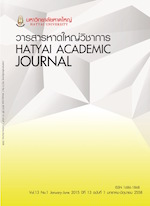องค์ประกอบคุณภาพชีวิตในการทำงานของพนักงานขับรถสองแถวโดยสารประจำทางในจังหวัดสมุทรสาคร
Main Article Content
Abstract
ผลการวิจัย พบว่า 1) เพศ อายุ สถานภาพ จำนวนบุคคลในครอบครัวที่ต้องรับผิดชอบ/ดูแล และ ประสบการณ์ในการขับรถสองแถวโดยสารที่แตกต่างกัน มีระดับคุณภาพชีวิตไม่แตกต่างกัน ส่วนการศึกษา รายได้ และการใช้เวลาในการขับรถสองแถวโดยเฉลี่ยต่อวันที่แตกต่าง มีระดับคุณภาพชีวิตแตกต่างกัน อย่างมีนัยสำคัญ 0.05 2) การวิเคราะห์องค์ประกอบเชิงสำรวจจากองค์ประกอบ 8 องค์ประกอบ ซึ่งมีตัวแปร ทั้งหมด 40 ตัว สามารถนำมาจัดกลุ่มให้เป็นองค์ประกอบใหม่ได้ 5 องค์ประกอบซึ่งมีผลต่อ คุณภาพชีวิต ในการทำงานของพนักงานขับรถสองแถว ดังนี้ องค์ประกอบที่ 1 การยอมรับทางสังคม ( = 3.76) องค์ประกอบ ที่ 3 ความปลอดภัยในการปฏิบัติงาน (
= 3.76) และองค์ประกอบที่ 2 มาตรฐานในการครองชีพ (
= 3.57) มีผลต่อคุณภาพชีวิตของพนักงานขับรถสองแถวในระดับมาก ส่วนองค์ประกอบที่ 4 ความสมดุลระหว่าง งานกับชีวิตส่วนตัว (
= 3.50) และองค์ประกอบที่ 5 โอกาสในการพัฒนาความสามารถของบุคคล (
= 3.47) มีผลต่อคุณภาพชีวิตของกลุ่มตัวอย่างในระดับปานกลาง ทั้งนี้ แต่ละองค์ประกอบสามารถอธิบาย ความแปรปรวนของตัวแปรทั้งหมด ได้ร้อยละ 65.48 จากตัวแปร 40 ตัว ที่มีค่าถ่วงน้ำหนักองค์ประกอบ อยู่ระหว่าง 0.50 - 0.75
Quality of Working Life Components of Bus Drivers in Samutsakorn
The purposes of this research were 1) to search for the quality of working life components of the bus drivers in Samutsakhon, 2) to study ways to enhance the quality of working life components of the bus drivers and 3) to compare life working quality of bus drivers who had different profiles. The sample utilized in this research included 348 bus drivers in Samutsakhon. The research tool was a questionnaire which had an acceptable content validity and reliability. Statistic description and analysis included frequency, percentage, mean, standard deviation, exploratory factor analysis, t-test, one-way analysis of variance, and multiple comparisons.
The findings revealed that 1) differences of gender, age, married status, family numbers, responsibility, and experience resulted in no significant difference in the quality of working life components. However, differences in education, income, hours of bus driving resulted in a difference in the quality of working life components at a 0.05 level of significance. 2) The exploratory factor analysis of 8 components, which are 40 variables can be group into 5 components to the quality of working life as below; component No.1 Social acceptance ( = 3.76), component No.2 standard of living (
= 3.57) and component No.3 safety during work (
= 3.76) had high impacts on the quality of working life components of bus drivers; while, component No.4 balance between work and component No.5 private life (
= 3.50) opportunity to improve personal ability (
= 3.47) had medium impacts on life working quality of bus drivers. Each component can be explained the variance of all variables. The 40 variables can be explained up to 65.48 percent with the weight of components between 0.50-0.75. Moreover,
Article Details
All submitted articles are subject to academic validation by qualified experts (peer review). The opinions expressed in each article of this publication are those of the authors themselves. The editorial board holds no responsibilities on them and does not reserve the copyright for academic use with the condition that the reference of their origin is cited.
